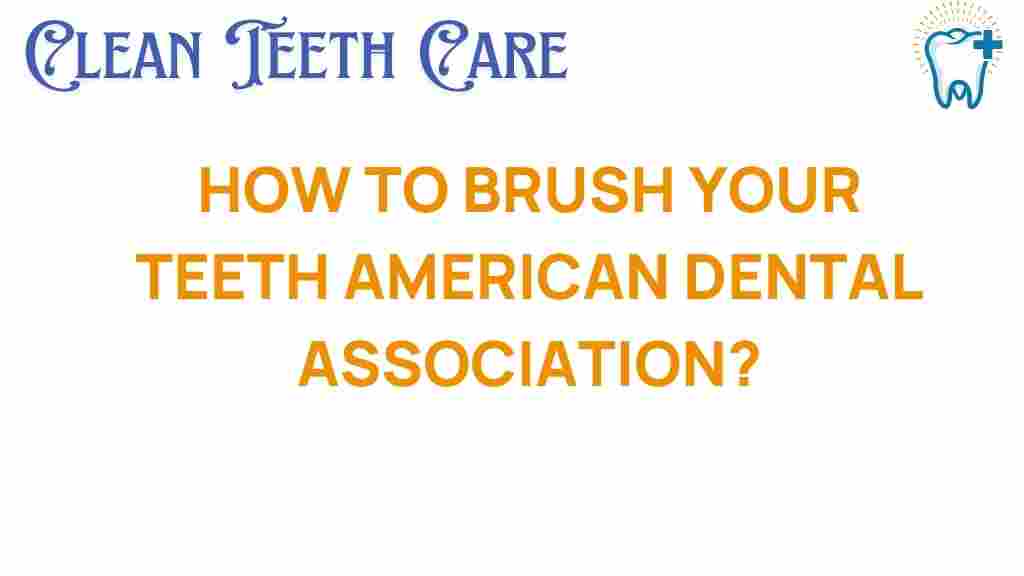Mastering the Art of Tooth Brushing: Tips from the ADA
Maintaining good oral hygiene is essential for healthy teeth and overall well-being. One of the most important components of oral care is tooth brushing. The American Dental Association (ADA) emphasizes that proper brushing techniques and habits can significantly reduce the risk of cavities and gum disease. In this article, we will explore effective tooth brushing techniques, provide valuable dental tips, and discuss the importance of children’s dental health.
The Importance of Tooth Brushing
Tooth brushing plays a crucial role in oral hygiene. It helps to remove food particles and plaque that accumulate on teeth, which can lead to cavities and other dental issues if not addressed. Regular brushing is essential for:
- Preventing cavities
- Reducing the risk of gum disease
- Maintaining fresh breath
- Promoting overall health
According to the ADA, brushing your teeth at least twice a day, especially after meals, is vital for effective dental care. However, the technique you use is just as important as the frequency.
Step-by-Step Tooth Brushing Technique
Here’s how to master the art of tooth brushing according to the recommendations from the American Dental Association:
- Choose the Right Toothbrush: Select a toothbrush with soft bristles and a head that fits comfortably in your mouth. Electric toothbrushes can also be effective.
- Use Fluoride Toothpaste: Apply a pea-sized amount of fluoride toothpaste to your brush. Fluoride helps strengthen tooth enamel and prevent cavities.
- Position the Brush: Hold your toothbrush at a 45-degree angle to your gums. This angle allows the bristles to reach below the gum line where plaque tends to accumulate.
- Gentle Circular Motions: Use gentle, circular motions to brush the outer surfaces of your teeth. Avoid aggressive scrubbing, which can damage your gums and enamel.
- Brush All Surfaces: Don’t forget to brush the inner surfaces of your teeth, as well as the chewing surfaces. Spend at least 30 seconds on each section of your mouth.
- Brush Your Tongue: Bacteria can build up on your tongue, leading to bad breath. Gently brush your tongue or use a tongue scraper.
- Rinse Thoroughly: After brushing, rinse your mouth with water to remove any remaining toothpaste and debris.
- Replace Your Toothbrush Regularly: Change your toothbrush every three to four months, or sooner if the bristles are frayed.
Dental Tips for Effective Tooth Brushing
To ensure you’re getting the most out of your tooth brushing routine, consider these helpful dental tips:
- Brush Twice a Day: Make it a habit to brush your teeth in the morning and before bed.
- Don’t Rush: Spend at least two minutes brushing your teeth. Use a timer or listen to a song to keep track.
- Use the Right Amount of Toothpaste: A pea-sized amount is sufficient for effective cleaning.
- Floss Daily: Flossing removes plaque and food particles from between your teeth that your toothbrush may miss.
- Visit the Dentist Regularly: Regular check-ups and cleanings are essential for maintaining oral health.
Cavity Prevention Strategies
In addition to proper tooth brushing, there are several strategies you can employ to prevent cavities:
- Limit Sugary Snacks: Reduce your intake of sugary foods and drinks that can contribute to tooth decay.
- Drink Plenty of Water: Water helps rinse away food particles and bacteria. It’s especially important after consuming sugary or acidic foods.
- Consider Dental Sealants: Talk to your dentist about applying sealants to your teeth. Sealants provide a protective coating that can help prevent cavities.
- Use Mouthwash: An antimicrobial mouthwash can help reduce plaque and prevent gum disease.
Children’s Dental Health
Establishing good oral hygiene habits at an early age is crucial for children’s dental health. The ADA offers the following tips for parents:
- Start Early: Clean your baby’s gums with a soft cloth after feedings, and introduce a toothbrush as soon as their first tooth appears.
- Make Brushing Fun: Allow your child to choose their toothbrush and toothpaste. Singing songs or using a timer can make brushing enjoyable.
- Supervise and Assist: Children should be supervised while brushing until they are about 7 or 8 years old. Assist them to ensure they are brushing effectively.
- Encourage Regular Dental Visits: Schedule dental check-ups every six months to monitor your child’s oral health.
Troubleshooting Common Tooth Brushing Issues
Even with the best intentions, some people may face challenges with their tooth brushing routine. Here are some common issues and solutions:
- Issue: Sensitive Teeth
Solution: If you experience sensitivity, consider using toothpaste specifically designed for sensitive teeth. Consult your dentist if the problem persists. - Issue: Bleeding Gums
Solution: Bleeding gums may indicate gum disease. Ensure you’re brushing gently and consistently. If bleeding continues, see a dentist. - Issue: Bad Breath
Solution: Ensure you’re brushing your tongue and using mouthwash. Persistent bad breath may require a dental check-up.
Conclusion
Mastering the art of tooth brushing is essential for maintaining healthy teeth and preventing dental problems. By following the American Dental Association’s recommendations and implementing effective brushing techniques, you can significantly improve your oral hygiene. Remember that regular dental visits and a balanced diet play a vital role in cavity prevention and overall dental care.
For more information on maintaining great oral health, visit the American Dental Association website. And don’t forget to check out our other articles for more dental tips and insights on children’s dental health.
This article is in the category Hygiene and created by CleanTeethCare Team
